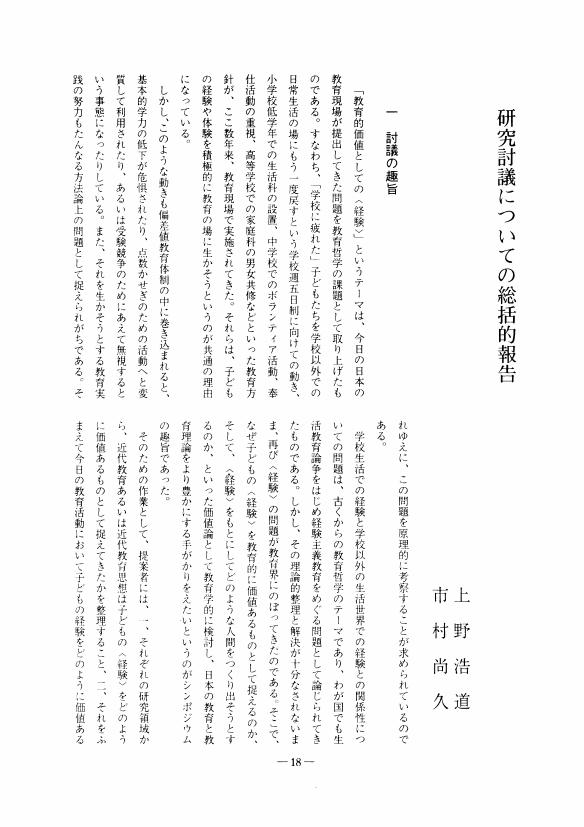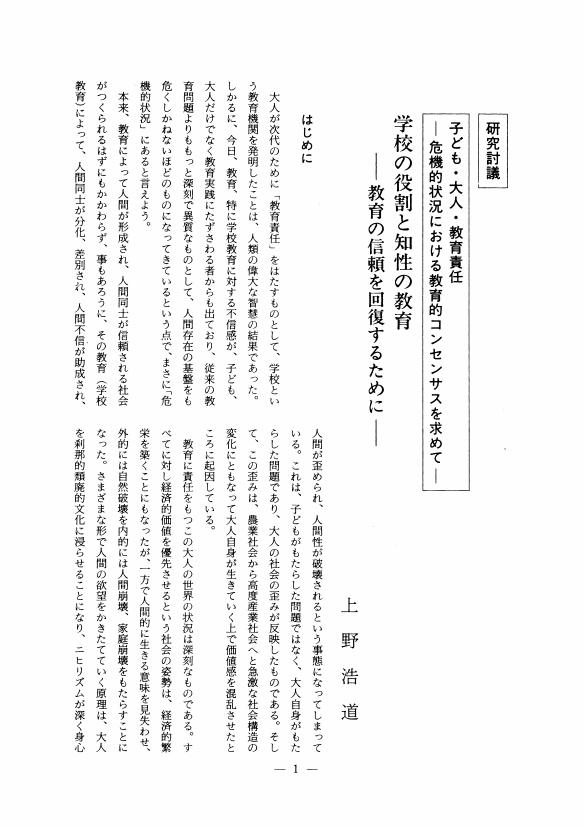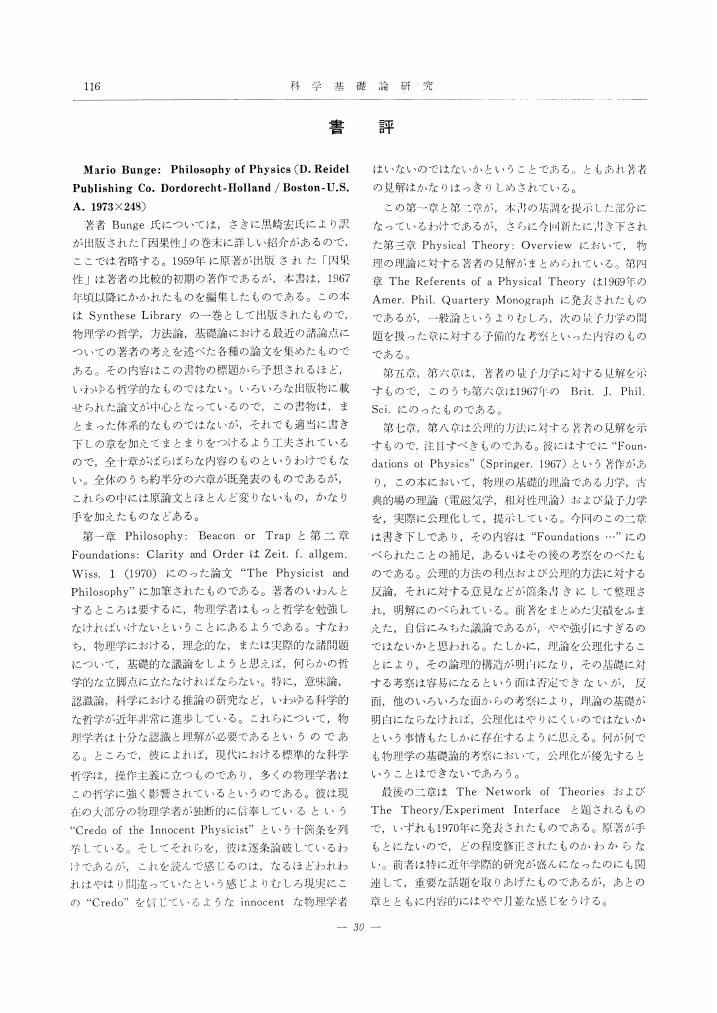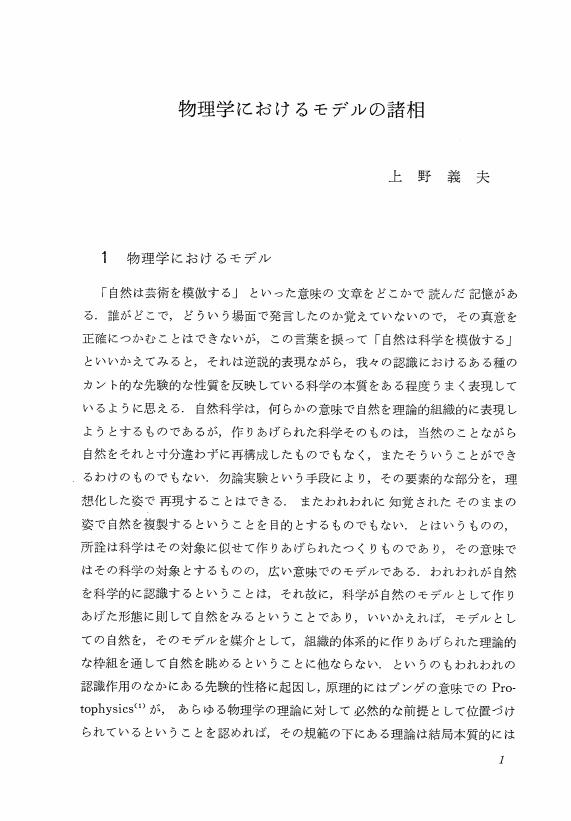1 0 0 0 OA 農地測量学
- 著者
- 上野英三郎, 兼松義隆 著
- 出版者
- 成美堂書店
- 巻号頁・発行日
- 1926
1 0 0 0 OA 和田修二『教育する勇気』
- 著者
- 上野 浩道
- 出版者
- 教育哲学会
- 雑誌
- 教育哲学研究 (ISSN:03873153)
- 巻号頁・発行日
- vol.1995, no.71, pp.119, 1995-05-10 (Released:2009-09-04)
1 0 0 0 OA 研究討議についての総括的報告
- 著者
- 上野 浩道 市村 尚久
- 出版者
- 教育哲学会
- 雑誌
- 教育哲学研究 (ISSN:03873153)
- 巻号頁・発行日
- vol.1995, no.71, pp.18-22, 1995-05-10 (Released:2009-09-04)
1 0 0 0 OA 市村尚久著『エマソンとその時代』
- 著者
- 上野 浩道
- 出版者
- 教育哲学会
- 雑誌
- 教育哲学研究 (ISSN:03873153)
- 巻号頁・発行日
- vol.1994, no.70, pp.64-65, 1994-11-10 (Released:2009-09-04)
- 著者
- 上野 浩道
- 出版者
- 教育哲学会
- 雑誌
- 教育哲学研究 (ISSN:03873153)
- 巻号頁・発行日
- vol.1990, no.61, pp.1-6, 1990-05-10 (Released:2009-09-04)
- 参考文献数
- 4
1 0 0 0 OA アメリカにおけるart educationの動向
- 著者
- 上野 浩道
- 出版者
- 教育哲学会
- 雑誌
- 教育哲学研究 (ISSN:03873153)
- 巻号頁・発行日
- vol.1986, no.53, pp.100-105, 1986-05-10 (Released:2009-09-04)
1 0 0 0 OA 学校教育と美意識の形成 西洋画教育受容の一形態
- 著者
- 上野 浩道
- 出版者
- 教育哲学会
- 雑誌
- 教育哲学研究 (ISSN:03873153)
- 巻号頁・発行日
- vol.1979, no.40, pp.16-31, 1979-11-30 (Released:2009-09-04)
- 参考文献数
- 22
It is a characteristic of art in Japan that there are two styles of painting, Japanese and Western. In nurturing their sense of beauty, Japanese have been influenced both by their indigenous artistic culture and by the expression and way of pursuing beauty on the part of foreign arts. This is particularly true in public art education in Japan, which imported a great many ideas of western painting to enrich the Japanese way of thinking and expression.The purpose of this paper is to clarify how the ideas of western painting influenced the viewpoint and expression of N. Inamori (1892-1978), who was an ordinary school teacher, that is; a typical Japanese.N. Inamori, who was brought up in the Japanese culture, nurtured his sense of beauty within its confines. Then, in school, he received ringa (conventional training in copying pictures in the textbook), jiyuga (style of painting free from textbook restraints) education and studied Western viewpoint and expression. However, he could not understand scientific and analytical perception and expression. Later, retiring from teaching, he did Japanese painting and calligraphy as his hobby.By pursuing the process of nurturing his sense of beauty and analyzing his paintings, the following three points were clarified. (1) The technique of line drawings by ringa influenced the form of his expression for a long time. While, jiyuga education made him perceive and portray the essense of nature and life directly. It put stress on children's individual freedom, inner expression and their subjective activity. (2) Education in Western painting taught him the importance of observing objects attentively and rationally ; scientifically, analytically and mathematically. Technically, it taught himthe lams of perspective and shading, so on. But, he could not understand the Western thought behind the techniques, especially the thought that aimed at the perfected ego and the development of science. (3) He could not perceive and paint nature objectively and concretely as a third party. Because, he does not perceive the world in opposition to ego, but he finds his self in the world. The emotion, viewpoint, and expression that he had experienced in his early days was his basic and fundamental way of perception, expression and sense of beauty.
1 0 0 0 OA ケーススタディに基づく看護職倫理教育の課題と展望
- 著者
- 上野 哲
- 出版者
- 日本医学哲学・倫理学会
- 雑誌
- 医学哲学 医学倫理 (ISSN:02896427)
- 巻号頁・発行日
- vol.25, pp.91-98, 2007-10-18 (Released:2018-02-01)
The main envisioned contribution of professional ethics education for nurses has been that it offers a clear and concrete antithesis to the previous professional ethics education methodology, according to which it was supposed that nurses would be able to make correct ethical judgments if a set of given standards were applied to clinical problems. It was assumed that students who became medical professionals would be able to make ethical judgments in the clinical workplace if the general principles of these standards were clarified. On this basis, students were taught the principles of these standards as part of their training. The antithesis by professional ethics education for nurses was to spotlight caring which had been ignored because a change to a clear knowledge of science had been impossible. Specifically, case studies were adopted as a method of education, and emphasized the following four points: (1) stimulating moral imagination, (2) recognizing ethical issues, (3) developing analytical skills, and (4) tolerating disagreements and ambiguities. However, in practice, professional ethics education for nurses based on case studies supplies the training of proof, rather than the training of creativity and flexibility. In this paper, I propose the possibility of use of case methods in place of case studies. Case methods offer the possibility of going beyond the limitations of case studies, since they require training in unfettered judgment unrelated to occupational evaluations.
1 0 0 0 OA 書評
1 0 0 0 OA 特殊相対性理論の基礎についての考察
- 著者
- 上野 義夫
- 出版者
- 科学基礎論学会
- 雑誌
- 科学基礎論研究 (ISSN:00227668)
- 巻号頁・発行日
- vol.16, no.1-2, pp.50-53, 1982-12-25 (Released:2009-07-23)
1 0 0 0 OA 書評
1 0 0 0 OA 物理学における理論の構成 特殊相対性理論の場合について
- 著者
- 上野 義夫
- 出版者
- 科学基礎論学会
- 雑誌
- 科学基礎論研究 (ISSN:00227668)
- 巻号頁・発行日
- vol.13, no.1, pp.27-31, 1976-11-25 (Released:2009-09-04)
- 参考文献数
- 8
1 0 0 0 OA 書評
1 0 0 0 OA 物理学基礎論について
- 著者
- 上野 義夫
- 出版者
- 科学基礎論学会
- 雑誌
- 科学基礎論研究 (ISSN:00227668)
- 巻号頁・発行日
- vol.9, no.3, pp.95-100, 1969-08-30 (Released:2010-01-22)
- 参考文献数
- 11
1 0 0 0 OA 物理学におけるモデルの諸相
- 著者
- 上野 義夫
- 出版者
- 日本科学哲学会
- 雑誌
- 科学哲学 (ISSN:02893428)
- 巻号頁・発行日
- vol.11, pp.1-12, 1978-10-20 (Released:2009-05-29)











